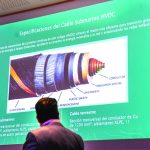Warns electricity grid stability must be maintained while migrating to renewables

Santo Domingo – Federico Martinez, an expert and consultant in the electricity sector, said that limiting the penetration of intermittent energy (solar and wind) is necessary until the cost of storing solar energy falls.
Martínez explained that the proposed regulation for distributed generation proposes a limit of 15% of the maximum demand as an aggregate of distributed generation (DG). Thus, the final purpose should be to move to 100% renewables while maintaining the stability of the electricity grid.
The specialist explained that for this, energy must be stored, and smart grids must be capable of managing the intermittency and variability of wind and photovoltaic sources. He pointed out that the country is far from that.
He said that between 2015 and 2023, the net non-renewable load on the electric grid in California has been drastically reduced in solar hours.
The electricity expert said that on December 19, the U.S. Energy Information Administration (EIA) published an article titled “As solar capacity rises, the ‘duck silhouette’ is getting deeper.”
Martinez pointed out that all this energy is produced cleanly and that fuel saving is a significant economic and environmental benefit; however, not everything is rosy.
“Electrical energy must be consumed as it is produced. There is no cost-effective way to store it. Batteries are still expensive, store a limited amount of energy, and have a limited number of charge and discharge cycles. Electricity grid operators are required to manage the energy that is dispatched depending on its cost and origin. This presents problems for which there are still no efficient solutions. For example, the stress of the system,” he said.
Giving the example of the Punta Catalina Thermoelectric Power Plant plant, he explained that “it takes two days to turn it off and at least one day to turn it on.
That implies that it must be on 24/7, designated as base generation. At noon, they can lower the load, but their efficiency drops. Like a car, at 20 km/h, it consumes more fuel per km driven than at 80 km/h.
Another problem is that even if your production is reduced at noon, it takes hours to increase production, and from 4:00 PM, when the sun goes down, the demand increase rises exponentially in two or three hours.”
He emphasized that engines and turbines can come online quickly; however, they suffer from the same fuel efficiency limitation at different load levels, which translates into a higher cost per kilowatt produced.

















